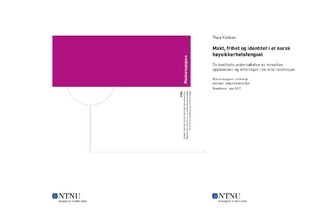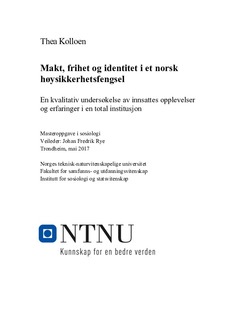| dc.description.abstract | This thesis is a sociological study of power, freedom and identity in a Norwegian maximum security prison. Inmates’ experiences are analyzed through how they are affected by the institution and their reactions in the prison as a total institution. This master thesis has one main question: How does the prison affect the inmates´ identities, and how do they react to it? Two sub questions are designed out of the main question: 1) How doesthe prison as a total institution affect the inmates control over their own bodies and their clothing practices? and 2) How can inmates use clothes to create freedom and their own identities? The sub questions investigate how inmates meet the prison structure and interpret it, and how they negotiate it through different adjustments. A qualitative method with interviews is used in the study.
I use Erving Goffman´s theory about total institutions in the research project. The theory offers a way to study the prison and how the inmates are affected by it. Goffman´s theory of total institutions suggests that the inmates´ identities are influenced and shaped by the prison. Goffman also suggests that the inmates have secondary adjustments where they can negotiate their identities. The theories of a total institution and secondary adjustments is the starting points in this research project. Michel Foucault´s definition of power is used to conceptualize power relations in the prison. I make use of Thomas Ugelvik´s previous research, and this master thesis is inspired by his study in a Norwegian maximum prison of power and resistance.
My main findings suggest that the prison is problematic for the inmates on three different levels: 1) Physically because of the lack of freedom, 2) Social control because the prison decides what the inmates can do with their bodies, and 3) The prison dress up the inmates´ bodies with prison clothes. In the analysis I propose that there is a distinction between the prisons physical and psychological impact. My main findings also suggest that it is possible for the inmates to negotiate their identities in the prison by using clothes. How much they affect their own situation depends on the participation in the relationship of power. Clothes can be used to negotiate identity of several reasons: 1) Normality, 2) Making a distance to the prison, 3) Making a distance to the old identity, 4) Symbolic resistance, and 5) To express affiliation. By using impression management, it is possible to negotiate identity because it offers the inmates’ a way of being more than just an inmate. However, it can be discussed whether it is possible for all the inmates to exercise freedom and to make their own identitiesthrough clothes. | nb_NO |

